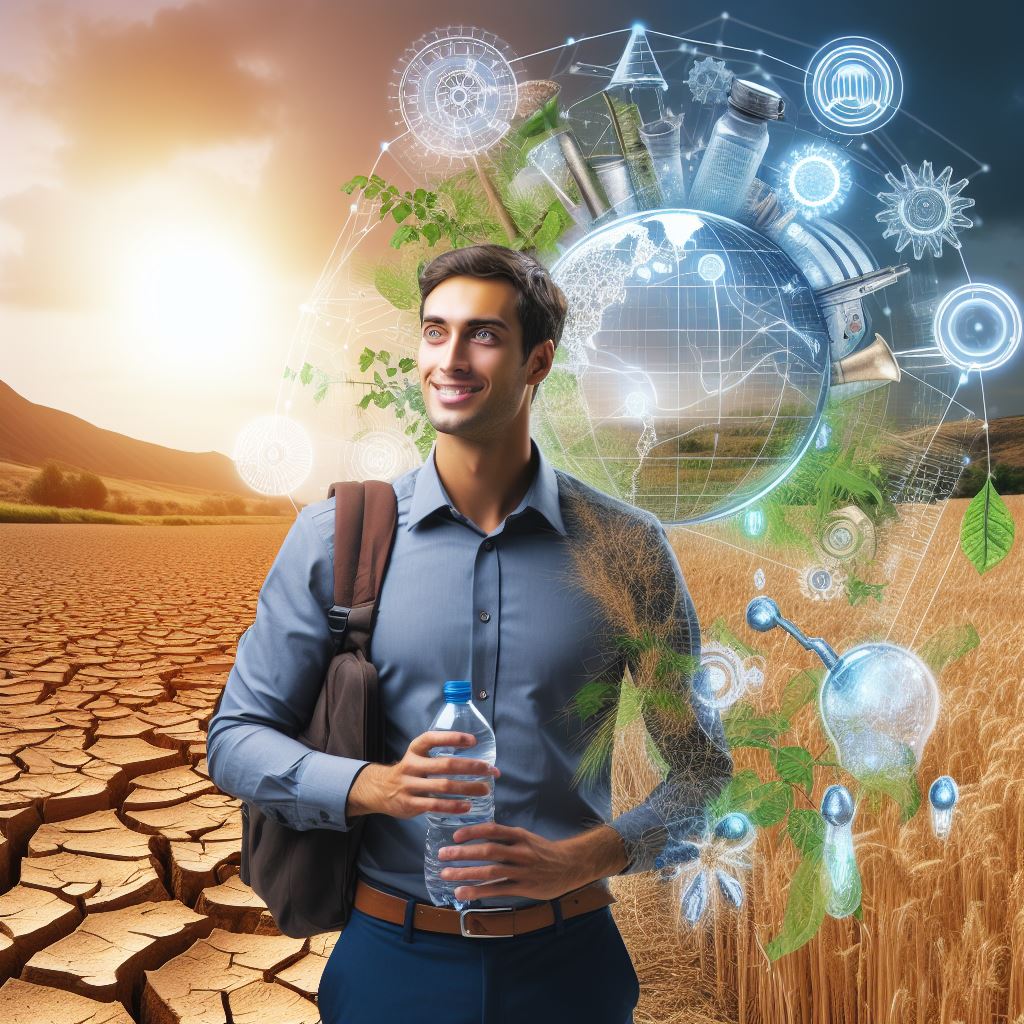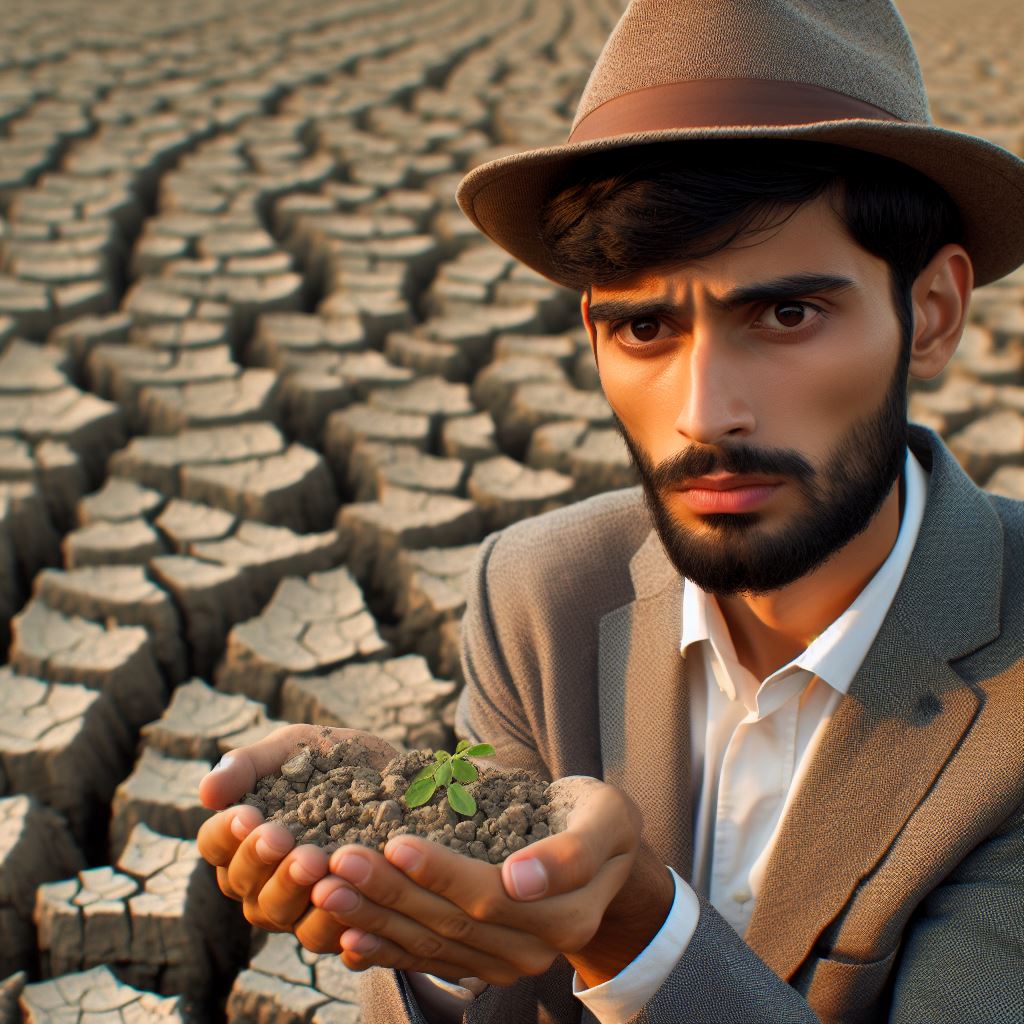Introduction
Let’s explore Tech Innovations in Drought Farming.
Drought farming is the practice of cultivating crops in arid regions where water availability is limited.
As droughts become more frequent and severe due to climate change, finding innovative solutions to enhance agricultural productivity in these areas has become essential.
Briefly introduce the importance of drought farming
One of the most significant technological advancements in drought farming is precision irrigation systems.
These systems use moisture sensors, weather forecasts, and data analysis to optimize water usage and deliver water directly to the roots of plants.
This enables better water management and reduces water wastage.
Scientists and researchers have developed crop varieties that can withstand drought conditions.
These crops are genetically modified to have enhanced water-use efficiency and tolerance to water scarcity.
Farmers can now rely on these resilient crops to minimize the impact of drought on their harvests.
Real-time monitoring of soil moisture is another innovation that aids drought farming.
Soil moisture sensors placed in the ground provide accurate data about soil water content, allowing farmers to make informed decisions about irrigation schedules.
This technology prevents overwatering or underwatering, optimizing water usage.
Cloud computing and data analytics have revolutionized agricultural practices, including drought farming.
Farmers can now access valuable information about weather patterns, soil conditions, and crop health through mobile applications and online platforms.
This data-driven approach helps them make timely and informed decisions to maximize crop yields.
Transform Your Agribusiness
Unlock your farm's potential with expert advice tailored to your needs. Get actionable steps that drive real results.
Get StartedState the purpose of the blog post – to discuss tech innovations in drought farming
In this blog post, we delve into the realm of drought farming and explore the latest technological innovations aimed at addressing this critical agricultural challenge.
We’ll examine cutting-edge solutions designed to mitigate the impact of water scarcity on crop production.
By highlighting innovative technologies such as precision irrigation systems, drought-resistant crop varieties, soil moisture sensors, and predictive analytics, we aim to showcase how advancements in agricultural technology are revolutionizing drought farming practices.
Through case studies and real-world examples, we’ll illustrate how farmers can leverage these tools to enhance water efficiency, optimize resource utilization, and maintain productivity even in arid conditions.
Our discussion will also touch upon the potential benefits and challenges associated with adopting these technologies, offering insights into their practical application and scalability.
Ultimately, this blog post serves as a comprehensive guide for farmers, researchers, and agricultural stakeholders interested in harnessing the power of technology to combat drought and ensure sustainable farming practices in the face of changing climate patterns.
Most importantly, technology has played a crucial role in improving drought farming techniques.
Precision irrigation systems, drought-tolerant crop varieties, soil moisture monitoring, and data-driven analytics have empowered farmers to mitigate the challenges posed by water scarcity and ensure sustainable food production in drought-prone regions.
What is drought farming
Drought farming refers to the practice of cultivating crops in areas that experience prolonged periods of little to no rainfall.
It involves using innovative techniques and technologies to maximize water conservation and crop productivity.
Definition and explanation
Drought farming is a method that involves growing crops in arid or semi-arid regions.
It relies on efficient water management strategies to overcome the lack of rainfall.
Farmers in drought-prone areas have to adapt and adopt innovative techniques to ensure sustainability.
These techniques aim to optimize water usage, increase crop yield, and minimize the impact of water scarcity on agricultural productivity.
Importance and challenges of drought farming
Importance of drought farming
Drought farming is crucial for food security in regions prone to water scarcity.
It helps farmers mitigate the impact of climate change, which exacerbates drought conditions.
By implementing drought farming practices, farmers can diversify their income sources and ensure economic stability.
It encourages sustainable farming practices by minimizing water wastage and promoting environmental conservation.
Challenges of drought farming
Water scarcity is the major challenge faced in drought farming.
Limited availability of water resources makes irrigating crops a significant hurdle.
The lack of rainfall restricts the growth and development of crops, affecting their yield and quality.
Drought farming requires an extensive knowledge of different crop varieties that can withstand water stress.
Farmers often face economic uncertainties due to fluctuating market prices and unpredictable weather patterns.
In order to overcome these challenges and make drought farming more efficient, various technological innovations have been developed.
Showcase Your Farming Business
Publish your professional farming services profile on our blog for a one-time fee of $200 and reach a dedicated audience of farmers and agribusiness owners.
Publish Your ProfilePrecision Irrigation
This technology allows farmers to deliver water directly to the root zone of the plants.
By using sensors and automated systems, farmers can adjust irrigation based on plant needs, soil moisture levels, and weather conditions.
Precision irrigation promotes water conservation and reduces water loss through evaporation and runoff.
Drip Irrigation
Drip irrigation involves delivering water slowly and directly to the roots of the plants.
It reduces water wastage by minimizing evaporation and ensuring efficient water uptake by the crops.
This technique also helps in preventing weed growth and reducing the risk of soil erosion.
Rainwater Harvesting
Rainwater harvesting involves collecting and storing rainwater for irrigation purposes.
It can be done through various methods such as rooftop rainwater collection, storage tanks, or underground reservoirs.
Rainwater harvesting provides an alternative water source during dry periods, reducing reliance on groundwater and surface water.
Soil Moisture Sensors
Soil moisture sensors are used to monitor the moisture content in the soil.
Farmers can utilize these sensors to determine when to irrigate and how much water to apply.
This technology helps in optimizing irrigation scheduling and prevents overwatering or underwatering of crops.
Crop Selection and Breeding
Scientists and farmers are developing crop varieties that are more resistant to drought conditions.
These drought-tolerant crops can withstand water stress and still produce satisfactory yields.
The selection and breeding of such crops play a vital role in ensuring agricultural sustainability in drought-prone regions.
In general, drought farming is a crucial practice for ensuring food security and sustainability in regions experiencing water scarcity.
Despite the challenges faced, innovative technologies such as precision irrigation, drip irrigation, rainwater harvesting, soil moisture sensors, and crop selection are helping farmers overcome these challenges.
By adopting these tech innovations, farmers can optimize water usage, increase crop productivity, and build resilience against drought conditions.
Read: Future of Farming: Tech against Climate Change
Historical perspective on drought farming
Despite their usefulness in their time, traditional drought farming methods had notable limitations that hindered long-term sustainability and productivity.
Agricultural communities often struggled with unpredictable weather patterns and water scarcity, leading to hardships and food insecurity.
Briefly discuss traditional methods used in the past
Rainwater harvesting was a popular practice, allowing farmers to capture rainwater during the wet season for use in the dry season.
However, reliance on rainfall made crops highly vulnerable to droughts, as water availability became unpredictable.
Additionally, storage infrastructure for rainwater harvesting was limited, restricting the amount of water that could be collected and used.
Crop rotation was another method employed by farmers to maintain soil fertility.
By alternately planting different crops, they hoped to reduce nutrient depletion and enhance the soil’s ability to retain moisture.
However, without modern soil testing and scientific guidance, farmers often struggled to implement effective crop rotation plans, resulting in inadequate nutrient replenishment and reduced yields.
Mulching, the practice of covering the soil with organic materials, aimed to conserve moisture and suppress weed growth.
While this approach had its benefits, it required a continuous supply of organic material, which was not always readily available.
Additionally, improper mulching techniques could hinder root growth and lead to nutrient imbalances.
Traditional irrigation methods, such as bucket or diversion channel irrigation, were labor-intensive and wasted significant amounts of water.
Inefficient distribution mechanisms often resulted in uneven watering, leaving some crops waterlogged while others remained parched.
The time and effort required to manually irrigate large areas limited farmers’ ability to expand their cultivation and increase production.
Intercropping, the simultaneous cultivation of different crops on the same piece of land, aimed to optimize resource utilization and reduce water requirements.
However, this practice increased the risk of pest infestations and crop diseases.
With limited knowledge of suitable crop combinations, farmers often struggled to manage intercropped fields effectively, leading to yield losses and economic setbacks.
Highlight the limitations and drawbacks of these methods
- Dependence on rain: Traditional methods heavily relied on rainfall, making farming uncertain during drought periods.
- Soil degradation: Continuous farming and lack of advanced techniques led to soil erosion and reduced fertility.
- Water wastage: Manual irrigation methods resulted in inefficient water distribution and excessive water use.
- Low productivity: Traditional methods lacked precision and efficiency, resulting in lower yield and income.
- Vulnerability to pests and diseases: Intercropping increased the risk of pest infestation and crop diseases.
The drawbacks of traditional drought farming methods pushed farmers and scientists to seek innovative solutions that could overcome these challenges.
By embracing technological advancements and scientific research, modern farming practices have revolutionized drought farming, increasing resilience, productivity, and sustainability.
Read: Rising Temps: How Crops Struggle and Adapt
Overview of Tech Innovations in Drought Farming
The role of technology in addressing challenges
Technology plays a crucial role in tackling the challenges faced by drought farming.
Showcase Your Farming Business
Publish your professional farming services profile on our blog for a one-time fee of $200 and reach a dedicated audience of farmers and agribusiness owners.
Publish Your ProfileWith advanced innovations, farmers can optimize their practices and maximize their yield even in water-stressed environments.
Utilizing precision agriculture techniques, such as remote sensing and global positioning systems (GPS), farmers can collect and analyze data to make informed decisions.
This allows for precise water and nutrient application, resulting in efficient resource use.
Soil moisture sensors enable farmers to monitor the water content in their fields at various depths.
This real-time data helps them make irrigation decisions, preventing overwatering or underwatering, and ensuring optimal plant growth.
Drip irrigation systems provide water directly to the plant’s roots, minimizing evaporation and runoff.
This technology allows for precise water application, reducing water wastage and improving water-use efficiency.
The wide range of tech innovations available
Various tech innovations have been developed to support drought farming practices, offering alternatives to traditional methods.
Farmers can collect and store rainwater through the use of rainwater harvesting systems.
This water can serve as a supplementary source during dry periods, reducing dependence on external water resources.
Hydrogels are materials that can retain significant amounts of water.
When added to the soil, hydrogels enhance water availability to plants, reducing the frequency of irrigation required.
Genetic modifications have enabled the development of drought-tolerant crop varieties.
These genetically modified plants have increased water-use efficiency and can withstand prolonged periods of drought, ensuring better productivity.
The impact of these innovations on water conservation and plant productivity
The implementation of these tech innovations has shown significant positive impacts on water conservation and plant productivity in drought farming.
By employing precision agriculture techniques and drip irrigation systems, water usage in agriculture is optimized.
Through efficient water application, these innovations help conserve water by reducing wastage and addressing inadequate water availability.
Tech innovations in drought farming enhance plant productivity by providing optimal water and nutrient availability.
Soil moisture sensors enable farmers to accurately monitor moisture levels, ensuring plants receive sufficient water without over-saturating the soil.
The use of rainwater harvesting systems and genetic modifications contributes to the resilience of crops.
Farmers can rely on stored rainwater and cultivate drought-tolerant plants, increasing their ability to withstand water scarcity and adverse climate conditions.
Generally, technology plays a crucial role in addressing the challenges faced in drought farming.
Precision agriculture techniques, drip irrigation systems, rainwater harvesting, hydrogels, and genetic modifications all contribute to water conservation and improved plant productivity.
By embracing these tech innovations, farmers can strive towards sustainable and efficient farming practices even in water-stressed environments.
Read: Climate Change: A Real Threat to Global Farming
Precision irrigation systems
The concept and benefits of precision irrigation
Precision irrigation systems have emerged as a promising solution to combat the challenges faced by farmers in drought-prone regions.
This innovative technology enables farmers to optimize water usage by delivering the right amount of water, at the right time, and in the right place.
By using precision irrigation systems, farmers can reduce water wastage, increase crop yield, and mitigate the negative impact of drought on their farms.
Precision irrigation systems are designed to provide water to plants in a targeted and efficient manner.
These systems utilize advanced technologies such as sensors, weather forecasting, and automation to optimize irrigation practices.
By monitoring soil moisture levels, weather patterns, and plant water demand, precision irrigation systems ensure that crops receive the necessary amount of water and nutrients, minimizing waste.
Different types of precision irrigation systems
There are different types of precision irrigation systems available, each tailored to suit different crop types, farm sizes, and water sources.
Drip irrigation is one of the most widely used precision irrigation techniques.
It delivers water directly to the plant’s root zone through a network of tubes and emitters, minimizing evaporation and runoff.
This method is particularly useful for fruit orchards, vineyards, and vegetable farms.
Another type of precision irrigation system is sprinkler irrigation.
This system distributes water through sprinklers, which can be fixed, rotating, or impact-based.
Sprinkler irrigation is suitable for larger areas and is often used in field crops, such as maize and wheat.
The precision of sprinkler irrigation can be enhanced by using technologies like soil moisture sensors and variable rate sprinklers that adjust water application based on crop requirements.
Examples of successful implementation in drought-prone regions
In recent years, precision irrigation systems have proved to be successful in drought-prone regions worldwide.
Showcase Your Farming Business
Publish your professional farming services profile on our blog for a one-time fee of $200 and reach a dedicated audience of farmers and agribusiness owners.
Publish Your ProfileFor example, in California, where water scarcity is a major concern, farmers have adopted precision irrigation techniques to effectively manage water resources.
By combining soil moisture sensors, weather data, and automation, farmers in California have significantly reduced water consumption while maintaining high crop yields.
Similarly, in Australia, precision irrigation systems have been implemented to combat the arid climate and prolonged droughts.
These systems have helped farmers optimize water usage, improve crop quality, and sustain agricultural production in challenging conditions.
By adopting precision irrigation techniques, farmers in Australia have been able to overcome water scarcity and increase their resilience to drought.
Precision irrigation systems have also been successfully implemented in developing countries, where water scarcity often threatens food security.
For instance, in India, farmers in the state of Gujarat have adopted drip irrigation systems to cultivate crops like cotton and vegetables.
These systems have not only increased crop yield but also reduced water usage by up to 50%, benefiting both farmers and the environment.
Basically, precision irrigation systems offer a promising solution to the challenges faced by farmers in drought-prone regions.
These innovative technologies enable farmers to optimize water usage, increase crop yield, and mitigate the negative impacts of drought.
With different types of precision irrigation systems available and successful implementation examples worldwide, precision irrigation holds great potential for revolutionizing drought farming and securing food production in water-scarce regions.
Read: Carbon Farming: Agriculture’s Climate Promise

Sensor-based monitoring and data analytics
How sensors aid in monitoring soil moisture, temperature, etc.
Sensor-based monitoring systems enable farmers to accurately track critical factors such as soil moisture levels, temperature, and other environmental variables.
These sensors are strategically placed in the fields to capture real-time data and provide valuable insights.
For instance, soil moisture sensors measure the amount of water present in the soil, allowing farmers to determine whether irrigation is necessary and how much water should be applied.
Temperature sensors help monitor the ambient temperature, which is crucial for making informed decisions regarding crop management and irrigation scheduling.
By continuously monitoring these metrics, farmers can ensure that the crops receive optimal conditions for growth and minimize water wastage.
The importance of data analytics in optimizing water usage
Data analytics plays a pivotal role in optimizing water usage in drought farming.
By analyzing the data collected from sensors, farmers can make informed decisions regarding irrigation schedules and water allocation.
These insights enable them to optimize water usage and conserve this scarce resource.
Through data analytics, farmers can identify patterns in soil moisture levels and temperature fluctuations, allowing them to develop precise watering plans.
By integrating weather data and crop water requirements, farmers can ensure that irrigation is only applied when necessary and in the required amount.
The ability to analyze data also helps farmers identify any anomalies or deviations from the expected values, allowing them to take corrective measures promptly.
This proactive approach minimizes water wastage, reduces costs, and improves the overall efficiency of drought farming practices.
Providing examples of sensor-based monitoring and data analytics applications in drought farming
- Crop-specific sensor systems: In drought farming, sensors specific to different crops can be deployed to monitor soil moisture, temperature, and other relevant parameters. For example, moisture sensors can be used to monitor the root zone moisture levels in vineyards, enabling grape growers to optimize irrigation and prevent water stress.
- Satellite-based monitoring: Remote sensing technologies combined with data analytics allow farmers to monitor a vast area of farmland efficiently. Satellite imagery provides valuable insights into vegetation health, water stress levels, and overall crop conditions, aiding in resource allocation and optimizing water usage.
- Automated irrigation systems: Sensor-based monitoring systems can be integrated with automated irrigation systems to enable precision irrigation. These systems evaluate real-time data from sensors and adjust irrigation schedules accordingly. This prevents over-watering and ensures crops receive the necessary moisture, reducing water waste.
- Smart farm management platforms: Software platforms integrate sensor data with advanced analytics algorithms to generate actionable insights for farmers. These platforms provide real-time information on soil moisture, temperature, and weather conditions, enabling farmers to make data-driven decisions to maximize yields while conserving water.
Essentially, sensor-based monitoring and data analytics have revolutionized drought farming by providing accurate and real-time information about soil moisture, temperature, and other variables.
With the help of these technologies, farmers can optimize water usage, minimize waste, and ensure the optimal growth conditions for crops.
As technology continues to advance, the future of drought farming looks promising, with the potential to mitigate the effects of water scarcity and improve agricultural sustainability.
Drought-tolerant crop varieties
The concept and benefits of drought-tolerant crops
Drought-tolerant crop varieties refer to plants that have been genetically modified or selectively bred to withstand dry and arid conditions.
These crops possess unique traits that enable them to thrive with limited water resources, making them highly suitable for drought-prone regions.
The benefits of drought-tolerant crops include increased agricultural productivity, reduced water footprint, and improved livelihoods of farmers.
The importance of biotechnology in developing such varieties
Biotechnology plays a crucial role in the development of drought-tolerant crop varieties.
By utilizing techniques such as genetic engineering and gene editing, scientists can introduce genes responsible for drought resistance into crop plants.
This enables the crops to better tolerate water scarcity, temperature fluctuations, and other adverse environmental conditions.
Biotechnology also allows for the targeted modification of specific traits, ensuring efficient and accurate development of drought-tolerant crops.
Successful examples of drought-tolerant crop varieties
Several successful examples of drought-tolerant crop varieties have been developed through biotechnology.
One notable example is genetically modified maize, which has been engineered to express a bacterial gene that enhances its tolerance to drought.
This innovation has significantly increased the productivity and resilience of maize crops in areas prone to water scarcity.
Another successful case is the development of drought-tolerant rice varieties through marker-assisted selection and genetic engineering.
These varieties exhibit improved yields and require less water, helping farmers mitigate the impact of droughts on their harvests.
Furthermore, genetically modified soybeans and wheat varieties with enhanced drught tolerance have also been developed, offering increased agricultural resilience.
Showcase Your Farming Business
Publish your professional farming services profile on our blog for a one-time fee of $200 and reach a dedicated audience of farmers and agribusiness owners.
Publish Your ProfileBy harnessing biotechnology, scientists and farmers can continue to innovate and develop even more effective drought-tolerant crop varieties.
Innovative Water Conservation Techniques
Water scarcity is a pressing issue in drought farming, but there are innovative techniques that offer hope.
These techniques, such as rainwater harvesting and drip irrigation, play a crucial role in conserving water and ensuring sustainable agriculture.
Techniques like rainwater harvesting, drip irrigation, etc
Rainwater harvesting is a technique that involves collecting and storing rainwater for future use.
It can be as simple as collecting rain in barrels or as advanced as using large tanks or underground reservoirs.
This technique has various benefits and potential applications in drought farming.
Another effective water conservation technique is drip irrigation.
Unlike traditional sprinkler systems, drip irrigation delivers water directly to the roots of plants in small, measured quantities.
This method minimizes water loss through evaporation and reduces the amount of water required for irrigation.
Benefits and potential applications in drought farming
One major benefit of rainwater harvesting is that it reduces the reliance on conventional sources of water.
Farmers can use the collected rainwater for irrigation, thus decreasing their dependence on scarce water resources.
This reduces the strain on the local water supply, especially during dry spells.
Additionally, rainwater harvesting helps to control soil erosion.
By capturing and redirecting rainwater, farmers can prevent soil erosion caused by heavy rainfall.
This protects the topsoil, which is vital for crop growth and water absorption.
By reducing soil erosion, farmers can maintain the fertility of their land and enhance the water-holding capacity of the soil.
Furthermore, rainwater harvesting promotes self-sufficiency and resilience among farmers.
During periods of drought, when water availability is limited, farmers who have implemented rainwater harvesting can rely on their stored water reserves.
This ensures a continuous water supply for their crops, improving the chances of a successful harvest.
The benefits of drip irrigation are abundant.
First and foremost, it maximizes water efficiency.
By delivering water directly to the roots, drip irrigation ensures that plants receive the necessary amount of water without wastage.
This is particularly important in areas experiencing water scarcity.
Moreover, drip irrigation saves time and labor for farmers.
Once the system is installed, it requires minimal maintenance and can be automated.
This allows farmers to focus their efforts on other aspects of farming, leading to increased productivity and reduced labor costs.
Include examples and case studies of successful implementation
A notable example of successful rainwater harvesting implementation is the “BARC method” in India.
This method, developed by the Bhabha Atomic Research Centre, involves constructing rainwater harvesting structures in rural areas.
These structures collect rainwater from rooftops and store them in underground tanks.
This initiative has enabled farmers to irrigate their crops even during long periods of drought, contributing to improved agricultural productivity.
A successful case study of drip irrigation is the Netafim Project in Israel.
This project, launched in the 1960s, revolutionized agriculture in the arid Negev desert.
Through the use of drip irrigation, farmers were able to cultivate various crops, including vegetables and fruits, in regions previously considered unsuitable for farming.
This led to the growth of a thriving agricultural industry and enhanced food security in the country.
Ultimately, innovative water conservation techniques like rainwater harvesting and drip irrigation have immense potential in drought farming.
These techniques not only conserve water but also offer multiple benefits such as reduced reliance on conventional sources, control of soil erosion, self-sufficiency, and increased productivity.
Successful implementation cases like the BARC method in India and the Netafim Project in Israel demonstrate the effectiveness of these techniques in mitigating the impacts of water scarcity for farmers.
Embracing such innovations can pave the way for sustainable agriculture in regions facing water shortages.
Future trends and possibilities
Research and development in drought farming
- Scientists and researchers worldwide are actively working on improving drought farming techniques.
- Efforts are being made to develop crops that can thrive in arid and water-stressed conditions.
- Genetic engineering is being explored to enhance the drought tolerance of existing crop varieties.
- Novel irrigation systems and water management strategies are being researched to optimize water usage.
- Data-driven technologies, such as remote sensing and drones, are being used for monitoring crop health and water stress.
- Scientists are also studying the microbiome of drought-resistant plants to understand their mechanisms of adaptation.
- Research is being done to identify and utilize indigenous plant species that can survive and yield in water-scarce regions.
Emerging technologies and innovations to watch out for
- Nanotechnology holds promise in developing smart materials with moisture-retaining capabilities for soil improvement.
- Artificial intelligence and machine learning algorithms can aid in predicting drought patterns and optimizing farming practices.
- Vertical farming systems using hydroponics and aeroponics have the potential to conserve water and maximize crop productivity.
- Cloud-based platforms and mobile applications are being developed to provide real-time information and guidance to farmers.
- Drones equipped with advanced sensors and imaging technologies can help detect early signs of crop stress and water deficiencies.
- Biotechnology research aims to enhance the water-use efficiency of crops through the manipulation of their genetic makeup.
- Smart irrigation systems that utilize soil moisture sensors and weather data can precisely deliver water where and when needed.
Speculate on the potential impacts of these advancements in the future
- The development of drought-tolerant crops and technologies can secure food production in water-limited regions.
- Efficient water management systems can help reduce water shortages and conflicts in agricultural landscapes.
- Drought farming innovations can contribute to sustainable agriculture by minimizing environmental impact.
- Increased crop yields in drought-prone areas can improve livelihoods and alleviate poverty among farming communities.
- Farmers adopting these advancements will be better equipped to cope with the challenges of climate change.
- Technological advancements in drought farming can promote economic growth and investment in agricultural sectors.
- Enhanced agricultural productivity can contribute to global food security and reduce reliance on imports.
Lastly, ongoing research and development in drought farming offer hope for a more resilient and sustainable agricultural future.
Emerging technologies and innovations hold the potential to address the challenges posed by water scarcity and climate change.
Showcase Your Farming Business
Publish your professional farming services profile on our blog for a one-time fee of $200 and reach a dedicated audience of farmers and agribusiness owners.
Publish Your ProfileBy harnessing the power of science and technology, we can create a future where farmers can thrive even in the face of extreme drought conditions.
The impacts of these advancements extend beyond agricultural productivity, encompassing economic, environmental, and social aspects of sustainable development.
It is crucial to support and invest in these efforts to ensure a prosperous future for both farmers and global food security.
Uncover the Details: Diverse Crops: Farming’s Climate Lifeline
Conclusion
Tech innovations in drought farming have revolutionized the agricultural industry.
These advancements have provided farmers with tools to mitigate the impact of drought on their crops.
It is essential to recognize the significance of these innovations in ensuring food security and sustainable farming practices.
By staying updated on the latest advancements in the field, farmers can maximize their yields and minimize water wastage.
The use of active voice in agricultural research and development is crucial for effective communication and implementation.
As technology continues to evolve, it is important for farmers and stakeholders to adapt and embrace new techniques.
Continuous monitoring and evaluation of tech innovations will help in improving efficiency and adaptation to changing climatic conditions.
Ultimately, the future of drought farming lies in the integration of cutting-edge technologies and scientific research.
By embracing these advancements, we can ensure a sustainable and prosperous agricultural sector for future generations.
Let us collectively work towards a world where drought farming becomes resilient, productive, and environmentally friendly.




